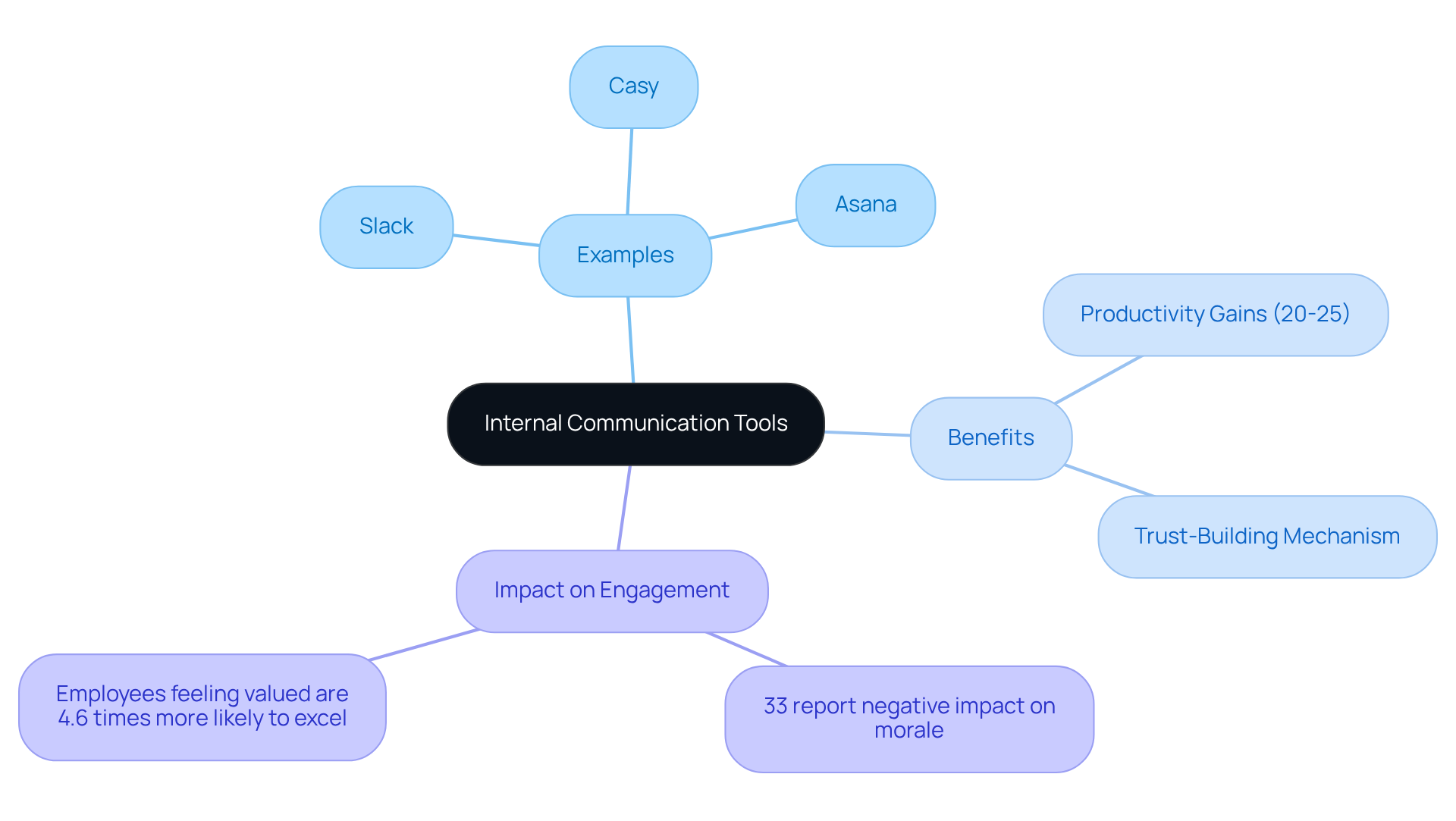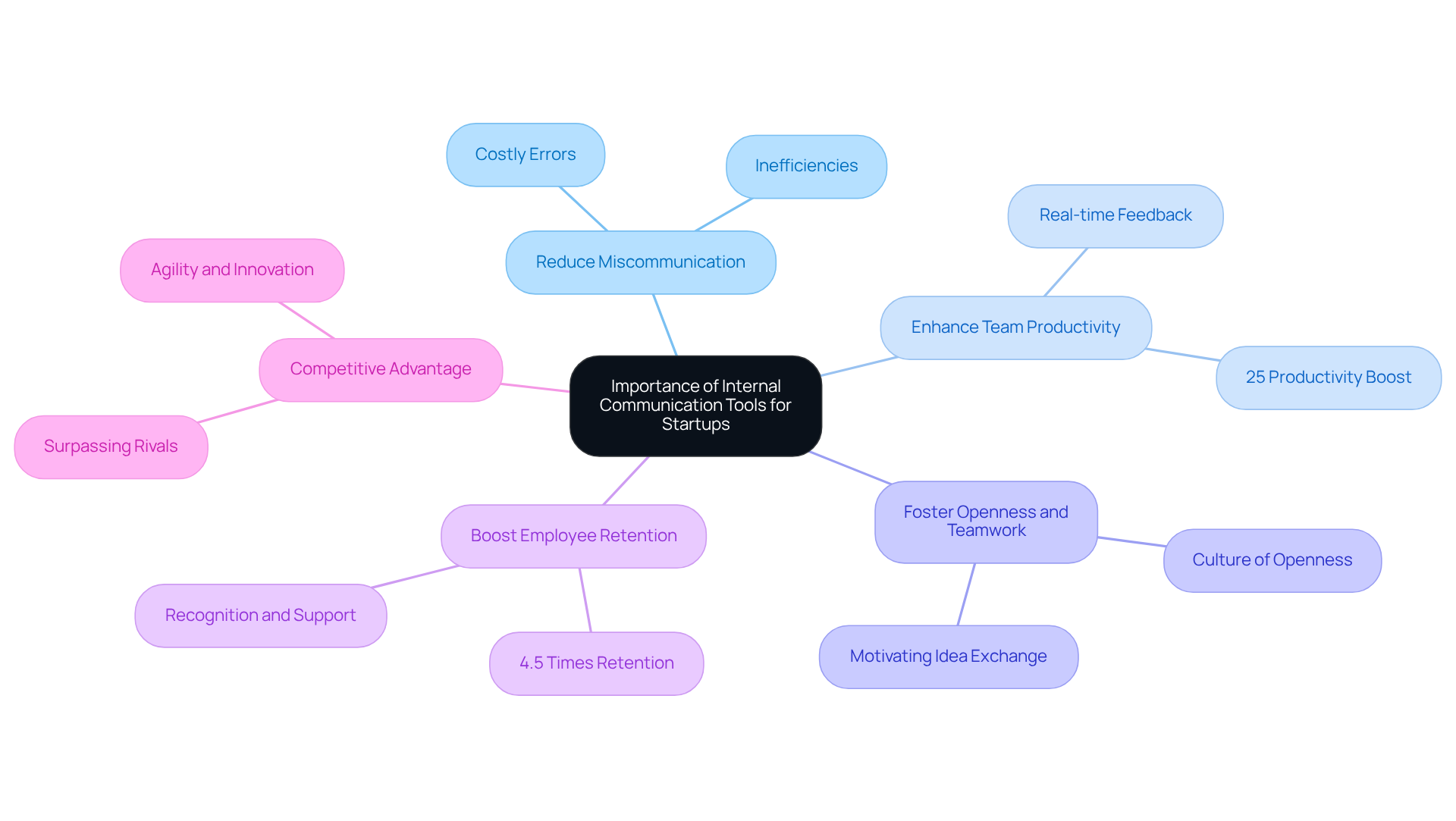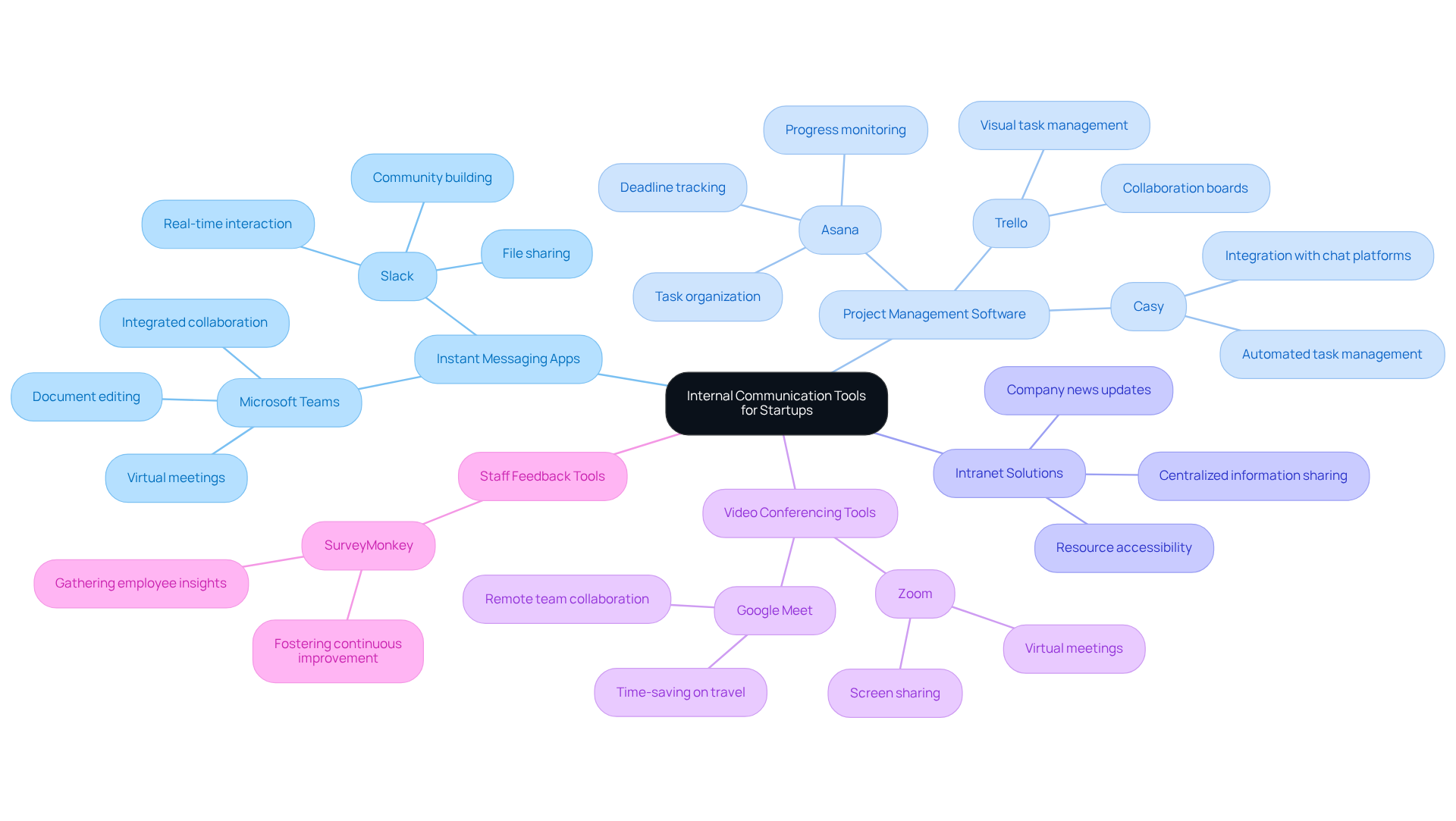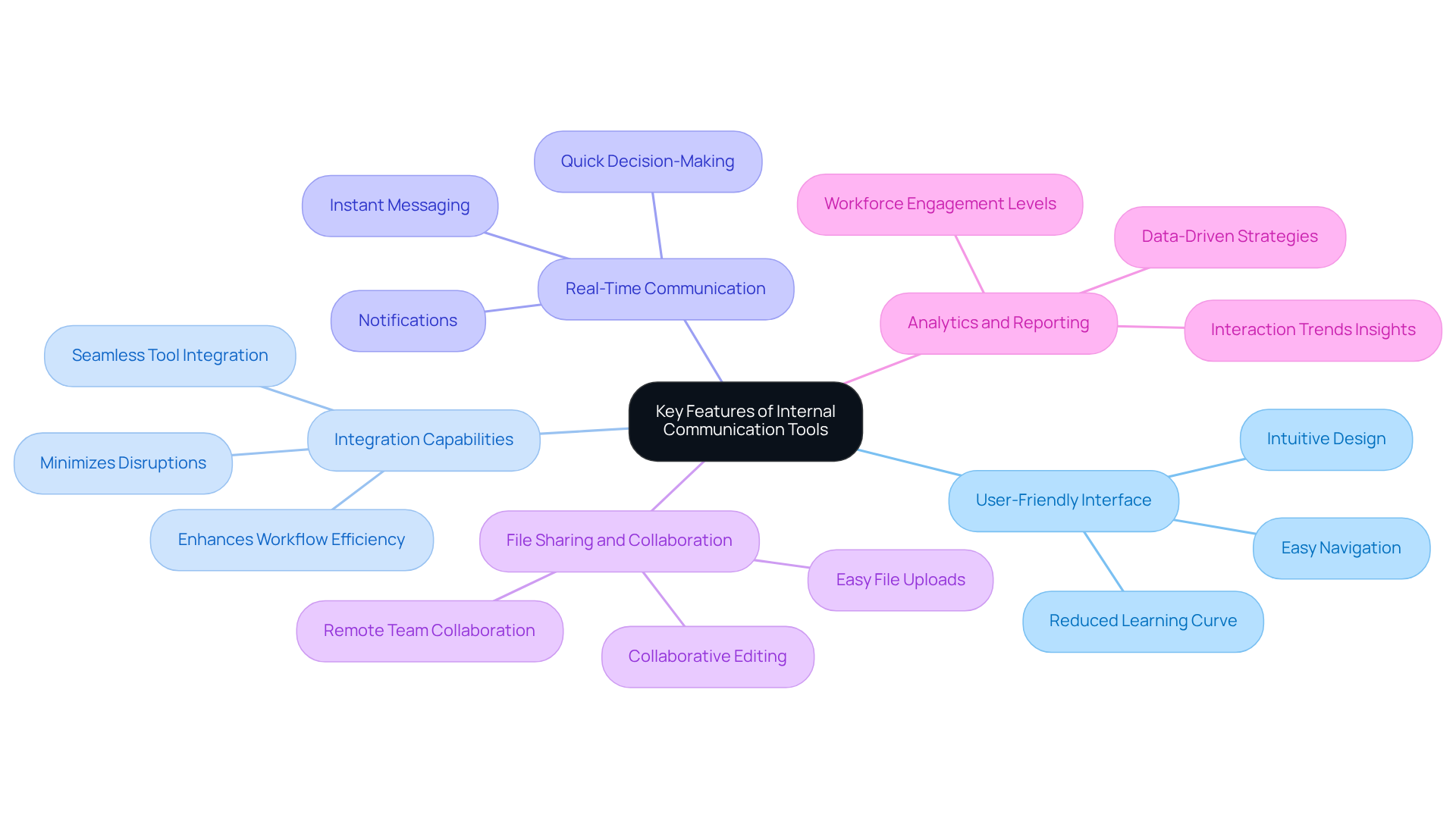Overview
The article underscores the critical role of internal communication tools for startups, emphasizing their capacity to enhance collaboration, mitigate miscommunication, and cultivate a positive work culture. Effective internal communication is not just beneficial; it can elevate productivity by an impressive 20-25% and significantly boost employee engagement.
How can startups leverage this potential? By recognizing that robust internal communication is pivotal to their success and growth, founders can implement strategies that foster a more engaged workforce.
Ultimately, the evidence is clear: investing in these tools is essential for the sustainability and advancement of new businesses.
Introduction
Internal communication tools stand as the unsung heroes of startup success, laying the essential framework for collaboration and information exchange in fast-paced environments. By harnessing these platforms, startups can significantly boost employee engagement, streamline workflows, and foster a culture of innovation and teamwork. Yet, with numerous options available, how can new businesses determine which tools will genuinely enhance their operations and drive growth? This article delves into the vital role of internal communication tools, exploring their types, benefits, and key features that can transform the dynamics of any startup.
Define Internal Communication Tools
Internal communication tools serve as vital software platforms that facilitate seamless interaction and collaboration among employees within an organization. By optimizing information exchange, these resources empower teams to share updates, collaborate on projects, and remain aligned on objectives. Common examples include messaging applications like Slack, project management systems such as Asana, and Casy, a project management application that integrates smoothly with chat platforms. In dynamic startup environments, where adaptability and swift responses are crucial, these tools significantly enhance interaction efficiency, fostering a cohesive work culture.
Consider this: organizations with engaged personnel can experience productivity gains of 20-25%. Internal messaging is emerging as the leading trust-building mechanism during uncertain times. Furthermore, effective internal communication is recognized as a key factor in employee engagement, with 33% of workers reporting that insufficient interaction negatively impacts morale. Employees who feel their voices are valued are 4.6 times more likely to feel empowered to excel in their roles.
By investing in robust internal communication tools, startups can cultivate an environment that not only promotes teamwork but also enables employees to thrive in their positions. Are you ready to enhance your team's collaboration and drive success?

Explain the Importance for Startups
For new businesses, internal communication tools are essential for several compelling reasons. First, they significantly reduce miscommunication, which can lead to costly errors and inefficiencies. In a business environment where teams are often small and resources are limited, clear communication is vital for maintaining focus and alignment on objectives. Furthermore, these platforms promote a culture of openness and teamwork, motivating team members to exchange ideas and feedback freely. This is particularly crucial in new ventures, where innovation and agility are key to success.
By utilizing internal communication tools, new businesses can enhance staff involvement, optimize processes, and ultimately foster growth. Research indicates that effective interaction strategies can boost team productivity by as much as 25%. Additionally, successful team dialogue enhances employee retention by 4.5 times compared to workplaces lacking an efficient interaction strategy. Moreover, businesses with efficient engagement strategies surpass their rivals by 3.5 times, underscoring the significance of these resources in cultivating a successful entrepreneurial atmosphere.
Consider Casy, for instance. It automatically captures key information from conversations, thereby reducing administrative overhead and addressing common pain points faced by startups. How could your team benefit from such a tool? The integration of efficient internal communication tools and strategies is not just an option; it is a necessity for thriving in today’s competitive landscape.

Identify Types of Internal Communication Tools
Startups can leverage various internal communication tools to enhance collaboration and efficiency, including:
-
Instant Messaging Apps: Tools like Slack and Microsoft Teams enable real-time interaction, allowing team members to chat, share files, and collaborate on projects seamlessly. These platforms are especially favored by new businesses for their capacity to enable rapid decision-making and nurture a sense of community. In fact, instant messaging applications are crucial for quick communication, as highlighted by the increasing trend of their usage in 2025.
-
Project Management Software: Platforms such as Asana and Trello help teams organize tasks, set deadlines, and track progress, ensuring alignment across projects. These internal communication tools are essential for new enterprises aiming to optimize workflows and monitor project statuses. Notably, Casy is an innovative project management solution that automates task management and integrates with chat platforms, addressing common pain points in project management for startups.
-
Intranet Solutions: Centralized platforms provide a space for sharing company news, resources, and documents, enhancing accessibility and information flow. Startups can utilize intranets to foster a cohesive company culture and keep staff informed.
-
Video Conferencing Tools: Applications like Zoom and Google Meet facilitate virtual meetings, making it easier for remote teams to connect and collaborate effectively. These tools are crucial for maintaining communication in hybrid work environments, as they save time and resources on travel, further emphasizing their importance.
-
Staff Feedback Tools: Tools like SurveyMonkey enable startups to gather insights and feedback from staff members, fostering a culture of continuous improvement. Consistent feedback aids organizations in adjusting and developing, ensuring that staff voices are heard. As Angela Ivey, Director of Corporate Communications, observed, effective means of interaction promote improved engagement among employees.
By comprehending these classifications, new enterprises can choose the internal communication tools that best meet their interaction requirements, ultimately improving efficiency and team unity.

Highlight Key Features and Characteristics
When evaluating internal communication tools, startups must prioritize several essential features:
-
User-Friendly Interface: A straightforward and intuitive design is crucial. This ensures that all team members can navigate the system effortlessly, significantly reducing the learning curve and enhancing adoption rates.
-
Integration Capabilities: The ability to seamlessly integrate with other essential tools, such as calendars and project management software, is vital. This enhances workflow efficiency and minimizes disruptions in daily operations. Research indicates that 60% of companies lack a long-term strategy for their internal interactions, highlighting the need for effective integration.
-
Real-Time Communication: Features that support instant messaging and notifications are essential for keeping teams connected and informed. They facilitate quick decision-making and responsiveness to evolving project needs. Efficient internal dialogue is crucial for the development and achievement of any new venture.
-
File Sharing and Collaboration: Tools that enable easy file uploads, sharing, and collaborative editing streamline project workflows. This allows teams to work together more effectively, regardless of their physical locations.
-
Analytics and Reporting: Integrated analytics offer significant insights into interaction trends and workforce engagement levels. This allows new businesses to enhance their strategies and boost overall effectiveness. Notably, employees are 3.7 times more likely to be engaged at work when their organization has a strong culture of recognition.
By concentrating on these characteristics, new ventures can choose internal communication tools that not only address their pressing interaction requirements but also foster long-term development and teamwork. This ultimately improves efficiency and group unity. Casy exemplifies these features with its integration capabilities and automated task management, making it an ideal choice for startups looking to streamline their internal communications.

Conclusion
Internal communication tools serve as vital resources that empower startups to excel by fostering collaboration and enhancing communication among team members. These platforms streamline information exchange and cultivate an environment where employees feel valued and engaged, ultimately driving productivity and innovation.
The discussion has underscored the significance of internal communication tools, emphasizing their role in minimizing miscommunication, promoting teamwork, and nurturing a culture of openness. Various tools—such as instant messaging apps, project management software, and video conferencing solutions—are critical for startups aiming to optimize workflows and maintain alignment on objectives. Furthermore, essential features like user-friendly interfaces, integration capabilities, and real-time communication are vital for effective implementation.
In conclusion, integrating robust internal communication tools is not just a strategy; it is a necessity for startups looking to navigate the competitive landscape successfully. By investing in these tools, new businesses can enhance collaboration, boost employee morale, and drive growth. Startups are urged to explore and adopt the right tools that align with their needs, ensuring they harness the full potential of effective internal communication to foster a cohesive and innovative work environment.
Frequently Asked Questions
What are internal communication tools?
Internal communication tools are software platforms that facilitate interaction and collaboration among employees within an organization, optimizing information exchange and empowering teams to share updates and collaborate on projects.
Can you provide examples of internal communication tools?
Common examples include messaging applications like Slack, project management systems such as Asana, and Casy, which integrates smoothly with chat platforms.
Why are internal communication tools important in dynamic startup environments?
In dynamic startup environments, internal communication tools enhance interaction efficiency, allowing for adaptability and swift responses, which fosters a cohesive work culture.
How does effective internal communication impact productivity?
Organizations with engaged personnel can experience productivity gains of 20-25%, and effective internal communication is recognized as a key factor in employee engagement.
What is the effect of insufficient internal communication on employees?
About 33% of workers report that insufficient interaction negatively impacts morale, highlighting the importance of effective communication.
How does valuing employee voices relate to their performance?
Employees who feel their voices are valued are 4.6 times more likely to feel empowered to excel in their roles, indicating the importance of internal communication in fostering empowerment.
What benefits do startups gain by investing in internal communication tools?
By investing in robust internal communication tools, startups can cultivate an environment that promotes teamwork and enables employees to thrive in their positions.




